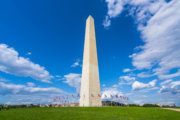SHARON COHEN
Associated Press
FERGUSON, Mo. (AP) — The images were reminiscent of a war zone: Helmeted officers pointing weapons from armored trucks, flash grenades lighting the night sky and tear gas exploding in crowded streets.
The ugly clashes between police and protesters in this St. Louis suburb fueled a torrent of criticism and raised questions about whether the officers’ tactics were inflaming the same violence they aimed to suppress after the fatal shooting of Michael Brown, an unarmed black teenager.
The repeated scenes of police officers wearing military-style camouflage and gas masks and training their rifles on unarmed civilians — some holding their hands up — looked to critics more like an Army trying to quell a revolution than a police department trying to keep the peace in a small suburb.
“It’s clear what is going on in Ferguson is a complete, hyper-exaggerated, hysterical response on the part of law enforcement,” said Thomas Nolan, a former Boston police officer and criminal justice professor at the State University of New York at Plattsburgh. “It’s clear that there is no one in charge and no one to corral the officers … and restrain them from engaging in an unprecedented show of brutal force against civilians. It’s horrifying and shameful and a disgrace.”
On Thursday, Gov. Jay Nixon announced that the Missouri State Highway Patrol would take over supervising security in Ferguson. He said the change was intended to ensure “that we use force only when necessary, that we step back a little bit.” The protests Thursday had a much lighter atmosphere, with several people stopping to shake hands with state police officers who walked among the crowd.
Nixon’s move, along with comments from a wide range of political figures calling for calm, came after protests had escalated late Wednesday into smoky chaos. Police lobbed tear gas to repel a crowd of about 150 protesters, some of whom had thrown Molotov cocktails and rocks at officers.
It was the fourth straight day of street confrontations spurred by Saturday’s fatal shooting of the 18-year-old by a white police officer. Police have declined to identify the officer, saying he has been the focus of death threats. More than 60 people have been arrested since Sunday.
Ferguson Police Chief Thomas Jackson said Thursday that police were trying to balance the public’s right to protest with public safety, including the need to keep streets open. But he added, “If firebombs are being thrown, property gets destroyed, shots get fired … we have to respond to deadly force.”
St. Louis County police spokesman Brian Schellman defended the actions of the officers. “In talking to these guys, it is scary,” he said. “They hear gunshots going off, and they don’t know where they’re coming from.” He also said coins, bricks and rocks also have been thrown at police. Two officers have been injured. One had an ankle broken by a thrown brick, according to authorities.
St. Louis Police Chief Sam Dotson told The Associated Press he was so concerned about the way Ferguson officers handled the unrest that he pulled his employees out. The city sent a 24-officer tactical squad to help control protesters Sunday and Monday night.
“I was concerned about the tactics,” Dotson said. “I was concerned about the safety of my officers.”
The police chief said he was not being critical because he was not there, but the actions taken in Ferguson were not “tactics I would use in the city of St. Louis.”
President Barack Obama and Attorney General Eric Holder aired their own doubts.
Obama, taking a break from his vacation, said while “emotions are raw now,” there needs to be a “respect for public order and the right to peaceful public protests.”
Holder said he was concerned that the use of military equipment by Ferguson police sent a “conflicting message.”
Missouri officials have accepted an offer from the Justice Department to help with crowd control and public safety “without relying on unnecessarily extreme displays of force,” he said.
During a visit to Ferguson, Sen. Claire McCaskill said “the militarization of the response became more of a problem than the solution. It escalated the situation. … These people need to be allowed to exercise their rights, with safety and respect.”
Mike McCollum, a resident of nearby Florissant, told McCaskill the police have created “a bullying environment.”
“We are not intimidated,” he said. “We are not scared to be shot. If a person can be killed unarmed, with their hands up, then I might as well fight,” he said. “That’s my mentality.”
The events in Ferguson were seen as part of a growing trend among police departments around the country.
In June, the American Civil Liberties Union released a report stating that police were overwhelmingly relying on SWAT raids — involving the use of assault rifles, battering rams and flash-bang grenades — for routine work such as searching for small amounts of drugs and serving warrants. These raids, the ACLU said, disproportionately affected minorities.
In several cases, the paramilitary-style approach led to tragedy, such as a 19-month-old baby critically injured when a flash-bang grenade landed in his crib.
Nolan said Ferguson authorities need to get rid of the advanced weapons and the armored trucks and appeal to Brown’s parents, community and religious leaders to stand with them and assure protesters there will be a thorough, impartial investigation into the teen’s death.
“The brute force — it’s not working,” Nolan added. “It hasn’t been working for four days. It’s time to reassess and time for someone to get in there with a calm head and say … ‘we need to try something different.'”
___
Cohen reported from Chicago. Associated Press writers Jim Salter and Jim Suhr contributed to this report.
Copyright 2014 The Associated Press. All rights reserved. This material may not be published, broadcast, rewritten or redistributed.







